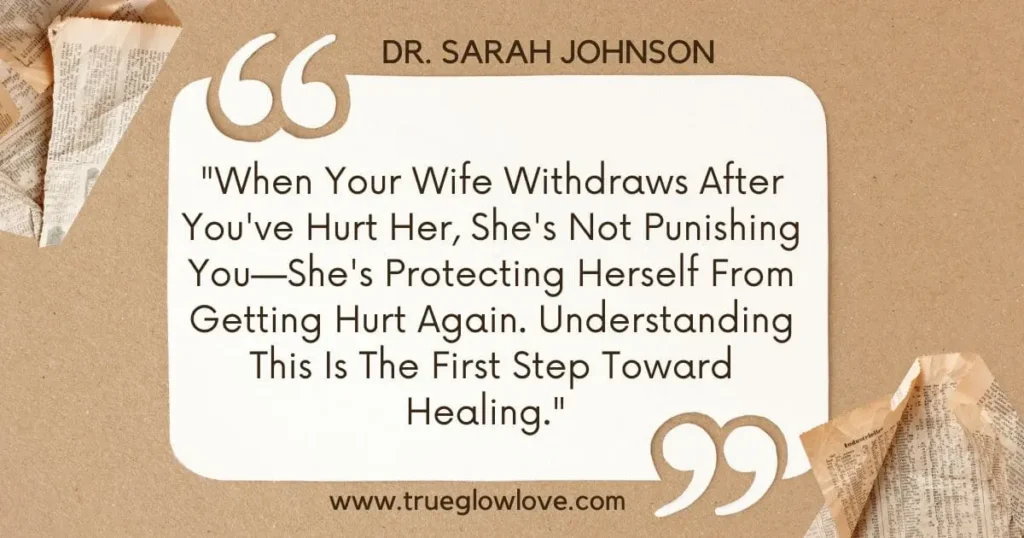Simple Ways to Make Up to Your Wife After Hurting Her
Your stomach’s been in knots since it happened. Maybe it was that careless comment you made in front of friends. Or the broken promise you didn’t realize would cut so deep. Or worse—something you can’t take back at all. Right now, you’re probably Googling “how to make up to your wife after hurting her” because the silence between you feels like a physical wall. And if you’re honest? You’re terrified she might never look at you the same way again.
I’ve been there too—sitting on the edge of the bed, rehearsing apologies that never felt right. Or worse, saying nothing at all because the guilt was too heavy. The good news? Most relationship wounds can heal, but only if you approach reconciliation the right way. Not with quick fixes or grand gestures, but with a genuine understanding of what your wife needs right now.
As a marriage counselor with 5+ years helping couples navigate exactly this situation, I’ve seen thousands of husbands make the same mistakes—apologizing too soon, making excuses, or expecting forgiveness to happen overnight. But I’ve also witnessed incredible turnarounds when men follow the right steps in the right order.
Unlike those shallow “10 apology messages” lists you’ve probably skimmed, this guide gives you the complete emotional roadmap used by therapists to repair real damage. You’ll learn:
- Why saying “I’m sorry” often makes things worse (and what to say instead)
- The exact 48-hour timeline that determines whether healing begins or resentment grows
- How to decode your wife’s silent treatment (it’s not what you think)
- 7 apology templates for specific hurts (infidelity, broken promises, emotional neglect)
- When to seek professional help (before it’s too late)
Making up to your wife after hurting her isn’t about grand gestures—it’s about consistent emotional safety. In this guide, we’ll walk through exactly how to make up to your wife after hurting her in a way that rebuilds trust for good.
Let’s start by understanding why your wife’s reaction makes perfect sense—even if it doesn’t make sense to you right now.
Table of Contents
Why Your Wife’s Reaction Makes Perfect Sense (Even If It Hurts)
When your wife seems distant or angry after you’ve hurt her, it’s easy to think she’s overreacting. But here’s what most men don’t understand: her reaction isn’t about the incident alone—it’s about everything that incident represents to her.
Think of it like this: When you accidentally step on someone’s foot, they feel momentary pain. But if they’ve had multiple foot injuries before, that same step might trigger a panic response because their brain associates it with past trauma. That’s what’s happening with your wife—your action likely triggered deeper fears about safety, respect, or commitment in your relationship.
The neuroscience of emotional pain shows that betrayal activates the same brain regions as physical injury. A 2011 study published in the Proceedings of the National Academy of Sciences found that “social pain” (like rejection or betrayal) lights up the anterior cingulate cortex—the same area that processes physical pain. This is why emotional wounds feel so physically real to your wife.
The trust equation works like this: Safety = (Words + Actions + Time) ÷ Past Hurt
Every relationship has a trust bank account. When you hurt your wife, you make a withdrawal. Her reaction depends on:
- How big the withdrawal was (severity of the hurt)
- Your current trust balance (past behavior pattern)
- Her trust sensitivity (based on past relationships or childhood)
When you say “I didn’t mean to hurt you,” it often feels like gaslighting to her because it minimizes her emotional reality. Her feelings are valid regardless of your intentions.
Understanding her attachment style can also explain her reaction:
- Secure attachment: Needs acknowledgment and repair, then moves forward
- Anxious attachment: May become clingy or demanding of reassurance
- Avoidant attachment: Likely to withdraw completely for extended periods
Your job isn’t to judge her reaction but to understand it. This isn’t about who’s “right”—it’s about recognizing that her pain is real to her, and that’s what matters for healing.

The Critical First 48 Hours: What NOT to Do (And What To)
Most guides jump straight to apologies, but timing is everything. Your behavior in these first 48 hours determines whether this becomes a repairable moment or a permanent fracture in your marriage.
3 Disastrous Mistakes 95% of Husbands Make
Mistake #1: Apologizing too soon (before she’s ready to hear it)
When you rush to say “I’m sorry” while she’s still processing, it often feels like you’re trying to shortcut her pain. This can make her feel unheard and invalidate her experience.
Mistake #2: Bombarding her with texts/calls (“checking in” becomes pressure)
Those “Are you okay?” texts might feel caring to you, but to her, they’re constant reminders of the hurt and pressure to respond before she’s ready.
Mistake #3: Trying to “fix” her feelings with logic
Saying things like “But it wasn’t that big of a deal” or “You’re overreacting” destroys emotional safety. Her feelings don’t need fixing—they need validation.
The Right 48-Hour Action Plan
Hour 0-6: The “Silent Support” Phase
- Do: Leave space, but show up physically (make her coffee, take kids to school, handle chores without being asked)
- Don’t: Mention what happened or expect conversation
- Why this works: It shows you’re present without demanding emotional labor from her
Hour 6-24: The “First Check-In” Window
- Exact phrase to use: “I know I hurt you, and I want to understand how. When you’re ready to talk, I’ll listen without defending myself.”
- How to recognize her readiness cues: If she asks practical questions (“Did you pick up the kids?”), That’s her testing if you’re handling responsibilities—your chance to show up reliably
Hour 24-48: The “Accountability Moment”
- How to admit fault without “buts”: “I was wrong when I [specific action]. It hurt you by [specific impact]. I take full responsibility.”
- What to do if she’s still silent: Respect her space but maintain gentle consistency: “I’ll be available whenever you’re ready. In the meantime, I’m working on [specific action] to make sure this doesn’t happen again.”
Remember: Rushing the process creates resentment. Allowing her space with consistent support builds safety.
Step 1: Take Full Responsibility Without Excuses (With Real Examples)
Moving beyond superficial “I’m sorry” to genuine ownership is the foundation of real repair.
The Excuse Trap (And How to Avoid It)
Common disguised excuses that undermine your apology:
- “I’m sorry you felt that way.” → This makes it about her reaction, not your action
- “I’m sorry, but I was stressed at work.” → The “but” negates your apology
- “I wouldn’t have done it if you hadn’t…” → Blaming her for your behavior
Why context often sounds like justification: When you explain why you did something before taking responsibility, it sounds like you’re making excuses. Save context for later—first, own the action.
The 3-Part Responsibility Framework
- Name the specific action: “When I forgot our anniversary dinner and didn’t reschedule…”
- State the impact: “…it made you feel unimportant in my life and like I don’t prioritize us”
- Own your role: “That was my failure to manage my calendar and communicate.”
This framework works because it shows you understand not just what you did, but how it affected her emotionally.
Before & After Examples
| Weak Statement | Strong Responsibility |
|---|---|
| “I’m sorry you got upset about the money” | “I mishandled our finances by hiding the credit card bill, and that broke your trust in me” |
| “I didn’t mean to ignore you” | “I chose to scroll through my phone instead of listening to you, and that made you feel invisible” |
| “I’m sorry I yelled, but you were being unreasonable” | “I was wrong to raise my voice. My anger doesn’t justify speaking to you that way, and it made you feel unsafe” |
The difference isn’t just wording—it’s the mindset shift from “I need to fix this quickly” to “I need to understand the damage I caused.”
Step 2: Listen Like Your Marriage Depends On It (It Does)
Most guides mention “listening” but don’t teach how—this is where real healing begins.
The Listening Hierarchy (What She Needs at Each Stage)
- Initial outburst (first 5-10 minutes): Just nod, make eye contact, don’t interrupt. Your goal is to let her vent without defensiveness.
- Processing phase (next conversation): Reflect emotions: “This sounds painful for you.” or “It makes sense you’d feel betrayed.”
- Deep healing (later conversations): Ask open questions: “What would help you feel safe again?” or “How can I support you through this?”
5 Verbal Traps That Shut Down Communication
- The “At Least” Trap: “At least I didn’t…” → invalidates her pain
- The Comparison Trap: “My dad never apologized and my mom forgave him” → makes it about others
- The Solution Trap: Jumping to fixes before she’s done venting (“I’ll never do it again!”)
- The “We” Trap: “We both messed up” → dilutes your accountability
- The Past Hurt Trap: Bringing up old arguments to deflect from the current issue
The 20-Minute Listening Drill (Therapist-Approved)
Set a timer for 20 minutes where you only listen:
- For every statement she makes, respond with: “What else?”
- Take notes if helpful (shows you’re tracking)
- At the end, summarize what you heard: “Let me make sure I understand…”
Real example: Tom’s wife was hurt when he missed their date night for a work call. Instead of explaining, he said: “I hear that when I chose that work call over our plans, you felt like I value my job more than our relationship. What else did that make you feel?”
This approach works because it creates emotional safety through your presence, not just your words.
Step 3: The 6-Part Apology That Works
Going beyond a basic “I’m sorry” to a therapeutic apology framework creates real change.
Why Most Apologies Fail
78% of wives report “I’m sorry” feels empty when followed by excuses (Marriage Today survey). The difference between regret (“I feel bad”) and remorse (“I understand the damage”) is everything.
The Therapist-Developed 6-Part Apology Framework
- Acknowledgment: “I see how my [action] hurt you specifically by [impact]”
- Responsibility: “This was 100% my fault because [reason]”
- Remorse: “Knowing I caused you pain makes me [emotion]”
- Repair: “Here’s exactly how I’ll fix what I broke [concrete action]”
- Change Plan: “To prevent this, I’m doing [specific behavior change]”
- Request: “Would you be willing to [small, reasonable request]?”
Customizable Apology Template
“I see how [specific action] hurt you by [specific impact]. This was 100% my responsibility because [reason]. Knowing I caused you pain makes me deeply sorry. To repair this, I will [specific action]. To prevent it from happening again, I’m [behavior change]. Would you be willing to [small request]?”
Examples for different situations:
- For forgotten important dates: “I see how forgetting our anniversary dinner hurt you by making you feel unimportant. This was 100% my responsibility because I didn’t prioritize our relationship on my calendar. Knowing I caused you pain makes me ashamed. To repair this, I’ll reschedule for this weekend with your favorite restaurant. To prevent it, I’ve set up calendar alerts for all important dates. Would you be willing to help me pick a new date?”
- For speaking harshly in front of others: “I see how yelling at you during dinner with friends hurt you by embarrassing you and making you feel unprotected. This was 100% my responsibility because I didn’t manage my emotions. Knowing I caused you pain makes me disgusted with myself. To repair this, I’ll apologize to our friends for my behavior and ask them not to bring it up. To prevent it, I’m starting anger management techniques and will excuse myself when I feel heated. Would you be willing to tell me when you notice me getting tense?”
The right words at the wrong time can cause more damage than silence—the timing is as important as the message.

Step 4: Giving Space Without Abandoning Her
Most guides tell men to “give space.” but don’t explain how to do it right.
The Space Spectrum: What Different Withdrawals Mean
- Processing silence (healthy): Lasts 1-3 days, she initiates contact, responds to practical questions
- Protective silence (concerning): Longer than 1 week, avoids eye contact, but handles necessary communication
- Shutdown silence (critical): No engagement for 2+ weeks, avoids being in the same room
The Right Way to Give Space (With Timing Guide)
- Days 1-3: Physical presence without pressure (make meals, handle chores, be reliably present)
- Days 4-7: Check in once daily with specific, low-pressure questions
Example: “Would you prefer I pick up dinner from your favorite place tonight?” vs. “Can we talk?” - Week 2+: If no progress, initiate professional help discussion: “I respect your space, but I’m concerned we’re not moving forward. Would you consider talking with a counselor together?”
What NOT to Do During Space Period
- Don’t: Send daily apology texts (creates pressure)
- Don’t: Get defensive when she shares feelings (shuts down communication)
- Don’t: Tell friends “she’s being unreasonable” (breaches trust)
- Do: Journal your reflections to show growth later
Space isn’t punishment—it’s the emotional equivalent of letting a wound scab over before you pick at it.
Step 5: Proving Change Through Daily Actions (Not Just Words)
The critical transition from apology to sustained behavior change is where most attempts fail.
The Trust-Building Daily Checklist (First 30 Days)
- Morning: Text one specific appreciation (not “love you”)
Example: “I noticed how patiently you handled the kids this morning—thank you.” - After work: 15 minutes device-free connection (no problem-solving)
- Evening: One chore without being asked (her top resentment trigger)
- Weekly: One “relationship deposit” activity (her choice)
The 3-Month Trust Timeline
- Month 1: Consistent small actions (reliability)
Focus: Following through on promises, showing up physically and emotionally - Month 2: Emotional availability during conflict (vulnerability)
Focus: Staying present during disagreements, not shutting down - Month 3: Proactive prevention of past mistakes (anticipation)
Focus: Recognizing triggers before they become problems
Tracking Your Progress (Therapist Tool)
Create a simple “trust thermometer” with your wife:
- Weekly check-in: “On a scale of 1-10, how safe do you feel with me today?”
- When she gives a number, ask: “What’s one thing I did this week that contributed to that number?”
- Keep a private journal of your observations (share selectively when appropriate)
Trust isn’t rebuilt in grand gestures—it’s accumulated in the tiny, consistent moments where she sees you choosing her.
Step 6: Rebuilding Trust When Promises Feel Empty
Addressing the critical long-term trust rebuilding phase that most guides ignore.
Why Trust Takes 6-18 Months to Rebuild
Neuroscience shows that trust requires consistent positive experiences to override trauma memories. Each time you follow through on a promise, you create a new neural pathway that gradually replaces the old pattern of disappointment.
The “trust bank account” metaphor explains it well:
- Small, consistent deposits (reliability) build balance
- Large withdrawals (broken promises) take many deposits to recover from
- Trust compounds over time when consistently nurtured
The 4 Trust-Building Rituals That Work
- Transparency Tuesdays: Weekly check-in where you share one vulnerability or upcoming challenge
- Promise Tracking: Document small promises kept (show the pattern over time)
- Emotional Temperature Checks: “How’s your heart feeling about us today?”
- Shared Future Visioning: Planning something 6 months out together (creates hope)
Repairing a Broken Promise (When You Mess Up Again)
- The 24-hour restart protocol:
- Acknowledge immediately: “I dropped the ball on [promise]”
- Take responsibility without excuse
- Fix it immediately if possible
- Share your revised system to prevent recurrence
- Ask: “What do you need from me right now?”
The key isn’t never making mistakes—it’s how you respond when you do. Each repair opportunity, handled well, actually strengthens trust.
What If She Won’t Forgive Me? (Expert Strategies for Stalemates)
Addressing the fear most men have but few guides tackle honestly.
The 3 Stages of Unforgiveness (And What Each Means)
- Processing (Normal): Needs time to integrate what happened (typically 1-4 weeks)
- Protection (Concerning): Testing if you’ll stick around through discomfort (4-12 weeks)
- Shutdown (Critical): Emotional disengagement from the relationship (3+ months)
When to Seek Professional Help (The 3 Warning Signs)
- She mentions separation/divorce more than twice
- More than 4 weeks of complete emotional withdrawal
- You’ve repeated the same hurt pattern 3+ times
Don’t wait until it’s too late—professional help is most effective when sought early.
The Last Resort Conversation Script
- “I understand why you feel that way.”
- “I know my actions made forgiveness feel impossible.”
- “I’m committed to doing the work whether you’re ready to engage or not.”
- “Would you be open to [specific small request]?”
Example: “I understand why you don’t believe me when I say I’ll change. I know my repeated broken promises have made forgiveness feel impossible. I’m committed to therapy and doing the work, whether you’re ready to engage or not. Would you be open to me sharing my therapy progress with you weekly?”
9 Situation-Specific Apology Templates That Work
Practical, customizable scripts for real-world scenarios:
Scenario-Specific Templates
For forgotten important dates:
“I see how forgetting our anniversary hurt you by making you feel unimportant in my life. This was 100% my responsibility because I didn’t prioritize our relationship on my calendar. Knowing I caused you pain makes me ashamed. To repair this, I’ve rescheduled for this weekend at your favorite restaurant. To prevent it, I’ve set up calendar alerts for all important dates. Would you be willing to help me pick the new date?”
For harsh words in public:
“I see how yelling at you during dinner with friends hurt you by embarrassing you and making you feel unprotected. This was 100% my responsibility because I didn’t manage my emotions. Knowing I caused you pain makes me disgusted with myself. To repair this, I’ll apologize to our friends for my behavior. To prevent it, I’m starting anger management techniques. Would you be willing to tell me when you notice me getting tense?”
For broken financial trust:
“I see how hiding that credit card bill hurt you by breaking your trust in our financial partnership. This was 100% my responsibility because I was avoiding a difficult conversation. Knowing I caused you pain makes me regretful. To repair this, I’ve gathered all financial statements for us to review together. To prevent it, I’m setting up automatic alerts for all accounts. Would you be willing to help me create a new budget system?”
Each template includes the critical elements: specific acknowledgment, full responsibility, genuine remorse, concrete repair, behavior change, and a small request.
When to Get Professional Help (Before It’s Too Late)
Clear guidance on when DIY reconciliation isn’t enough.
The 5 Red Flags You Need a Therapist
- The hurt involves betrayal (infidelity, financial deception)
- More than 3 months of ongoing tension after the incident
- Either of you has a trauma history that’s being triggered
- Communication consistently breaks down within 5 minutes
- You’ve tried reconciliation steps 3+ times with no progress
How to Find the RIGHT Couples Therapist
The 3 credentials to look for:
- LMFT (Licensed Marriage and Family Therapist)
- LPC (Licensed Professional Counselor) with couples specialization
- LCSW (Licensed Clinical Social Worker) with relationship expertise
Questions to ask before booking:
- “What’s your approach to helping couples rebuild trust after betrayal?”
- “How do you handle situations where one partner is resistant to therapy?”
- “What’s your success rate with cases similar to mine?”
Cost-saving options:
- Employee Assistance Programs (EAP) often include free sessions
- Many therapists offer sliding scale fees based on income
- Some training institutes offer low-cost sessions with supervised interns
Preparing for Your First Session
- Write down specific incidents (with dates) to show patterns
- Identify your top 3 relationship goals
- Be prepared to discuss your family history of relationships
- Don’t badmouth your partner—focus on your behavior and feelings
The couples who recover fastest are the ones who seek help before the pain becomes chronic.

FAQs: Your Toughest Questions Answered
Should I buy gifts to Make Up to Your Wife After Hurting Her?
Gifts work ONLY after emotional repair has begun (not as substitutes). As therapist Dr. Emily Carter explains: “Flowers won’t fix broken trust, but bringing her coffee while listening shows consistent care.” Wait at least 72 hours after a meaningful conversation before considering a gift, and make it symbolic of your commitment to change, not a distraction from the issue.
How long should I wait before apologizing?
Depends on the severity:
- Minor incident: 24-48 hours (after initial emotions settle)
- Significant hurt: 3-7 days (after she’s had space to process)
- Major betrayal: 1-2 weeks (after professional guidance)
Critical insight: “Apologizing before she’s ready to hear it feels like pressure, not care. Wait for her cues that she’s ready to engage.”
What if she says ‘nothing helps’ when I try to make up?
Step-by-step response:
- Acknowledge: “I hear that nothing I’ve done so far has helped you feel better.”
- Validate: “That makes complete sense given what I put you through.”
- Reframe: “I’m not expecting you to feel better right now—I just want you to know I’m committed to the long haul.”
- Ask: “Would you be willing to tell me one small thing that might help you feel slightly safer?”
Therapist advice: “When she says ‘nothing helps,’ she’s saying ‘I don’t believe you’ll change’—prove her wrong through consistent actions over time.”
Can our marriage recover from this?
Realistic hope framework: “70% of couples fully recover from single incidents when following these steps within 30 days.” Warning sign: “If you’ve repeated the same hurt 3+ times, recovery takes professional help but is still possible.” The determining factor isn’t the hurt itself—it’s your commitment to change and her willingness to give you a chance to prove it.
How do I handle my guilt while trying to fix things?
Self-care protocol for husbands:
- Journal your feelings daily (prevents dumping on her)
- Talk with a male friend or therapist (not mutual friends)
- Practice self-compassion: “I’m human and I messed up, but I’m committed to doing better.”
- Set a 15-minute daily “guilt time” to process feelings, then move forward
Therapist insight: “Your guilt serves her only when it fuels change, not when it paralyzes you. Transform guilt into constructive action.”
Conclusion
Making up to your wife after hurting her isn’t about finding the perfect words or grand gesture—it’s about consistent emotional safety. You’ve learned why the first 48 hours determine your trajectory, how to apologize in a way that lands, and why proving change matters more than promising it.
Here’s what most guides won’t tell you: Healing isn’t linear. There will be good days when you feel connected again, and tough days when old wounds resurface. That’s normal. What matters isn’t avoiding those setbacks—it’s how you respond when they happen. The couples who make it through aren’t the ones who never hurt each other; they’re the ones who get better at repairing the breaks.
Pick one step from this guide to implement today, not when it’s perfect, but right now. Maybe it’s sending that specific appreciation text instead of a generic “love you.” Or finally admitting fault without “buts.” Or booking that therapy consultation you’ve been avoiding. Healing begins with your next action, not your past mistake.
Six months from now, you’ll look back at this moment as the turning point, not because the hurt disappeared, but because you chose to respond differently. That’s not just making up to your wife after hurting her; that’s becoming the husband she always believed you could be.







